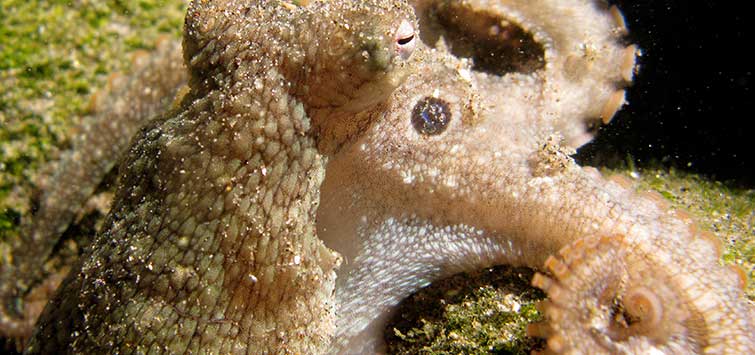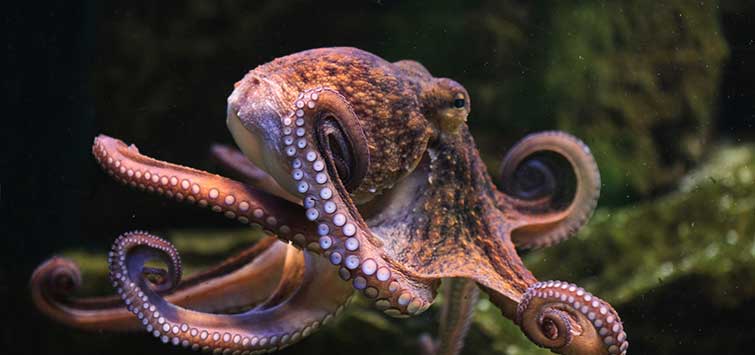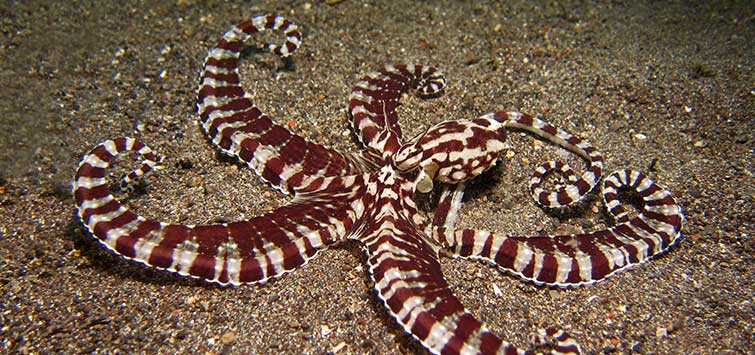An Octopus Success
Author: Zyan Silver
It started out as a simple high school project, but by the time this young aquarist was finished learning about octopuses, he was a successful breeder!
Fascinated Since High School
It started as a project during my senior year in high school. I was at school in southern Oregon and needed a project to fulfill the new graduation requirements set forth by the state. I was interested in marine biology and decided that raising an octopus species would be a challenging educational experience. With my father as my mentor, I did my homework and researched octopuses, and I quickly learned that they are fascinating animals.
Mysterious and Misunderstood
Octopuses are part of a mysterious and misunderstood group of invertebrates called cephalopods, which includes squid, cuttlefish, and nautiluses. Cephalopod means “head-footed,” and when you look at an octopus you can immediately appreciate why. Octopuses are efficient predators living almost exclusively on live foods. They are active hunters that stalk and ambush crustaceans and gastropods, their favorite foods. They are fast-growing and short-lived, most surviving less than two years.
Physical Characteristics
Octopuses have eight limbs with suction discs. The body, or mantle, contains all the organs and is without an internal or external shell. At the base of the tentacles is a parrot-like hard beak. These animals hunt using their excellent vision; their well-developed eyes come complete with iris, lens, and retina, similar to vertebrate eyes, in an example of convergent evolution.
Biology
An usual aspect of their biology is the fact that they have three hearts. Their gills receive water by the pumping action of the mantle drawing water in, and a funnel-like tube (siphon) squirts water out of the gill cavity when the body is contracted. They can aim this in different directions and use it for jet propulsion. They can also produce a black ink as a method of defense. This ink can be squirted as a visual screen, or to distract predators. As it forms a cloud, the octopus then will turn pale and jet away.
Part of the octopus’s secretive nature is its complex skin. They are masters of rapidly changing color and shape, and they can use these abilities for camouflage, mimicry, alarm display, and communication. Special color structures called chromatophores are responsible for this incredibly rapid response. There are millions of these special cells that can be turned on and off in a fraction of a second. The texture of the octopus’ skin can change to form flaps and spikes, and their free-flowing body allows them to squeeze through the tiniest openings.
Intelligent and Intriguing
Armed with all of this knowledge, I picked Octopus bimaculoides as the species to study and raise. Affectionately known as bimacs, these medium-size octopuses reside in southern California coastal mudflats and tidal pools. Most octopuses are nocturnal, but these are active during the day. They have two ocelli (eye spots) and are often called the two-spot octopuses. We know little about their mating habits, but the female lays eggs once at the end of her life. This species lays large eggs measuring about ½ inch in length. Because its eggs are so large in size and so few in number (about 100 to 200), this is an ideal octopus to raise. The hatchling octopus must have live food the size of the octopus itself at birth. This type of food was available to me locally—another reason why this was such an ideal specimen for me to study.
In contradistinction, most octopus species lay thousands of tiny eggs which hatch into an initial planktonic lifestyle. These almost-microscopic newborns spend their early days in the water column eating zooplankton; this makes captive-raising them problematic.
Social Behavior
A few other behaviors make captive husbandry of octopuses difficult as well. They are asocial animals, loners that only get together to mate. They also tend to be cannibalistic, requiring isolation in closed aquarium systems.
Masters of Disguise
Octopuses seem more like higher life forms with an innate intelligence approaching that of animals like cats and dogs. Each individual has its own temperament and can learn rudimentary behaviors. These creatures are masters of disguise, putting the chameleon’s legendary skills of camouflage to shame. In captivity they quickly learn to recognize and interact with their keepers.
Setting Up a Home
With the goal of maximizing my chance to achieve success in captive husbandry, I set up my temperate saltwater aquarium system. I assembled a 500-gallon seawater system in my garage. Although my parents live on the ocean, I used artificial salt for the water. I plumbed three large tanks together with a commercial chiller and oversized protein skimmer. I had a functioning biological filter consisting of live rock and live sand. Aware that water quality was crucial to success, I wanted pristine, highly oxygenated water.
Octopuses have transparent blue blood due to a copper-based pigment that is less efficient at carrying oxygen than the iron-based hemoglobin in our red blood. The water parameters in the tank were a specific gravity of 1.026, with ammonia, nitrite, and nitrate levels undetectable.
The water temperature was kept at 60° to 68°F with the use of the chiller. Octopuses are notorious escape artists, so their enclosures must be escape-proof. Nothing is sadder than finding your beloved pet dried up and dead on the floor or behind a nearby piece of furniture. Fortunately for me, bimacs seem to have less inclination to leave their watery homes. They will, however, explore every nook and cranny in the aquarium and can squeeze thru the smallest openings—their beak is the only part of their body that is not compressible.
I had several circulation pumps to ensure adequate movement of the water. I had to be certain that all pipes and tubes that led to the pumps were adequately covered or screened. The dim fluorescent light in the garage was ideal, as these animals shun the bright lights commonly found in tropical reef aquariums.
The Octopus Arrives
It was June 2006 and my system was now ready and awaiting an octopus. From southern California via overnight courier came an adult female with a clutch of eggs in a clay pot. For the next two months this mother octopus tended to her eggs inside a den, never leaving her lair. The elongated ½-inch eggs were clustered like grapes hanging from the roof of the clay pot. Although I offered her food, I never saw her eat. She constantly aerated and caressed the eggs, oxygenating them with jets of clean water. This loving care is necessary to ensure the viability of these developing eggs. She cleaned the egg cases with her suckers to prevent buildup of bacteria and algae, and also protected them from possible predation. Eventually I could see the black eyes peering from the translucent eggs—it was a sign that the hatch date was near.
Baby Octopuses!
On August 5 it happened. A baby octopus appeared and was swimming free in the aquarium. It was a miniature version of the adult, and it was able to crawl, jet, ink, and change color and shape. Suddenly there was another, then another, and even more. Over the next seven days 125 babies hatched. Beyond hatching there is no care provided by the mother and they must fend for themselves immediately. My work was just beginning. The mother, her work done, died 10 days later. This is the norm with these animals, and this semelparous nature is yet another fascinating fact about octopuses.
I didn’t know how many eggs were glued to the roof of that clay pot, hidden by the mother octopus, but I certainly didn’t have 100 containers. I collected the babies, isolating them in 2- to 4-liter plastic bottles inside the large tanks. The tops and bottoms of the bottles were cut off and replaced by mesh screen for adequate water flow and circulation. Initially I housed the juveniles in groups of three to five per container, and over the next weeks I was able to collect enough containers to separate each one. I flushed the containers daily to keep the water clean and clear. I supplied them with little shells for dens and toy blocks for entertainment.
My secret to success was being able to supply the juveniles with live foods of the appropriate size. I collected this food from the nearby local tide pools. I had previously traveled to the area just south of Los Angeles to view their natural habitat; I explored the tide pools and scuba dived along the rock coastline, and I decided that the tiny intertidal snails, crabs, and hermit crabs would be an excellent initial food source. Octopuses eat gastropods, crustaceans, and fish. Although their favorite food is crabs, snails are a bigger part of their diet due to their relative abundance. I collected hundreds of 1- to 4-mm black turban snails from the higher intertidal zone by simply brushing them off the rocks into my collection bucket. I made certain that the captives had these varied foods available to them at all times.
Growing Up
The once-tiny octopuses grew quickly. I would be entertained for hours just by watching them explore their small spaces, crawl over the surfaces, and occasionally jet with their siphons. I had been told that I would be lucky to raise four or five babies out of a clutch. Over the months as the bimac babies grew I realized that there were only a few deaths. I kept their containers clean and flushed. Bigger food items replaced the smaller as the young grew.
Their absolute favorite food was the shore crabs, which—though armed with sharp pincher claws—were no match for the guile of the octopuses. They delighted in subduing two or more at one time. Then, holding the crabs under their umbrella-like webbing at the base of their arms, the octopus would slink back to their hideout for a tasty treat. The empty shells would pile up around the dens. In the wild, when these middens are encountered, it is a sign to an astute observer that an octopus lives nearby.
It was fun playing tug-of-war with the octopuses; they could exert quite a force with their twin rows of suction discs. The more you pull, the more they pull. You can definitely feel their power when they draw your fingers into their eight-arm embrace. Often the young would hide, with their arms placed around their mantle, covered with empty shells.
With more than 100 young octopuses in my possession, I started contacting others who were interested in keeping these animals as pets. Finding the Internet site tonmo.com, The Octopus News Magazine Online, was truly an inspiration. Interacting with like-minded fans of cephalopods was a complete joy. After I was approved as a shipper, I began sending octopuses around the country.
A Great Reward
When I initially contacted the carrier and told them I wanted to ship live octopuses, I was told that it sounded dangerous. The staff person said they needed to contact their legal department and would get back to me. This is the common response of the uninitiated.
Octopuses seem to be eerie, mysterious denizens of the deep, often described in literature as dangerous and monstrous beasts. I suppose that an animal with eight arms that glides through inner space, doesn’t have a backbone, is secretive, and can alter its appearance in the blink of an eye may seem frightening. However, those that take the time to get to know them realize they are unique, misunderstood pets that are hard to forget. When you look at them and they look back at you, you can tell there is a true intelligence there—you realize that they are wondering and thinking about you, just as you are wondering about them.
Only those lucky enough to spend time with octopuses can fully appreciate these beautiful creatures. I continue to observe the 50 octopuses I have at my home. I’ve set up some room-temperature tanks and am experimenting with group assemblies of bimacs. They seem to at least tolerate each other as long as they are provided plenty of food and spaces to hide in. I am hopeful that I will be able to captive-breed this species as they move into adulthood. It may be time for you to check out a pet octopus like O. bimaculoides—you will be rewarded with the experience of a lifetime!

.png?h=595&iar=0&w=2781&hash=5FD5E69473BCC22199FBFA2FB71B6033)



